Exploring Interests and Challenges in Australian Vocational Education
VerifiedAdded on 2023/06/04
|7
|1850
|377
Essay
AI Summary
This essay examines the Australian government's involvement in Vocational Education and Training (VET), focusing on their key interests and the significant challenges they encounter. The government's interests are primarily centered around enhancing the country's economic position and improving employment opportunities for its residents through a skilled workforce. However, challenges such as limited funding and difficulties in securing workplace learning opportunities hinder the effectiveness of VET programs. The essay highlights the importance of cooperation among all stakeholders to overcome these challenges and improve the overall VET system, emphasizing the need for adequate resources and practical training environments to ensure students acquire the necessary skills for successful employment.

[Vocational education and training in australia]
Paraphrase This Document
Need a fresh take? Get an instant paraphrase of this document with our AI Paraphraser
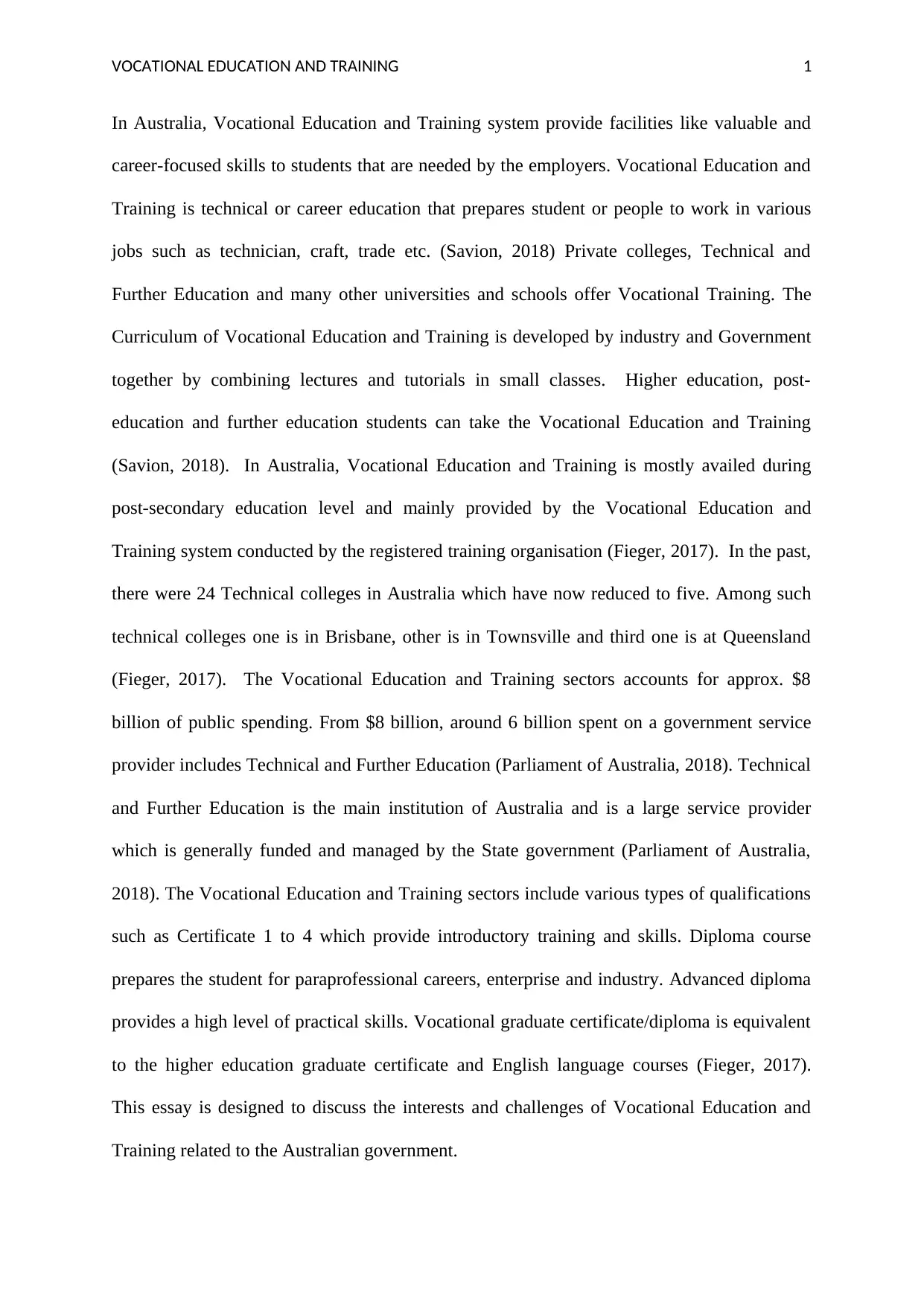
VOCATIONAL EDUCATION AND TRAINING 1
In Australia, Vocational Education and Training system provide facilities like valuable and
career-focused skills to students that are needed by the employers. Vocational Education and
Training is technical or career education that prepares student or people to work in various
jobs such as technician, craft, trade etc. (Savion, 2018) Private colleges, Technical and
Further Education and many other universities and schools offer Vocational Training. The
Curriculum of Vocational Education and Training is developed by industry and Government
together by combining lectures and tutorials in small classes. Higher education, post-
education and further education students can take the Vocational Education and Training
(Savion, 2018). In Australia, Vocational Education and Training is mostly availed during
post-secondary education level and mainly provided by the Vocational Education and
Training system conducted by the registered training organisation (Fieger, 2017). In the past,
there were 24 Technical colleges in Australia which have now reduced to five. Among such
technical colleges one is in Brisbane, other is in Townsville and third one is at Queensland
(Fieger, 2017). The Vocational Education and Training sectors accounts for approx. $8
billion of public spending. From $8 billion, around 6 billion spent on a government service
provider includes Technical and Further Education (Parliament of Australia, 2018). Technical
and Further Education is the main institution of Australia and is a large service provider
which is generally funded and managed by the State government (Parliament of Australia,
2018). The Vocational Education and Training sectors include various types of qualifications
such as Certificate 1 to 4 which provide introductory training and skills. Diploma course
prepares the student for paraprofessional careers, enterprise and industry. Advanced diploma
provides a high level of practical skills. Vocational graduate certificate/diploma is equivalent
to the higher education graduate certificate and English language courses (Fieger, 2017).
This essay is designed to discuss the interests and challenges of Vocational Education and
Training related to the Australian government.
In Australia, Vocational Education and Training system provide facilities like valuable and
career-focused skills to students that are needed by the employers. Vocational Education and
Training is technical or career education that prepares student or people to work in various
jobs such as technician, craft, trade etc. (Savion, 2018) Private colleges, Technical and
Further Education and many other universities and schools offer Vocational Training. The
Curriculum of Vocational Education and Training is developed by industry and Government
together by combining lectures and tutorials in small classes. Higher education, post-
education and further education students can take the Vocational Education and Training
(Savion, 2018). In Australia, Vocational Education and Training is mostly availed during
post-secondary education level and mainly provided by the Vocational Education and
Training system conducted by the registered training organisation (Fieger, 2017). In the past,
there were 24 Technical colleges in Australia which have now reduced to five. Among such
technical colleges one is in Brisbane, other is in Townsville and third one is at Queensland
(Fieger, 2017). The Vocational Education and Training sectors accounts for approx. $8
billion of public spending. From $8 billion, around 6 billion spent on a government service
provider includes Technical and Further Education (Parliament of Australia, 2018). Technical
and Further Education is the main institution of Australia and is a large service provider
which is generally funded and managed by the State government (Parliament of Australia,
2018). The Vocational Education and Training sectors include various types of qualifications
such as Certificate 1 to 4 which provide introductory training and skills. Diploma course
prepares the student for paraprofessional careers, enterprise and industry. Advanced diploma
provides a high level of practical skills. Vocational graduate certificate/diploma is equivalent
to the higher education graduate certificate and English language courses (Fieger, 2017).
This essay is designed to discuss the interests and challenges of Vocational Education and
Training related to the Australian government.
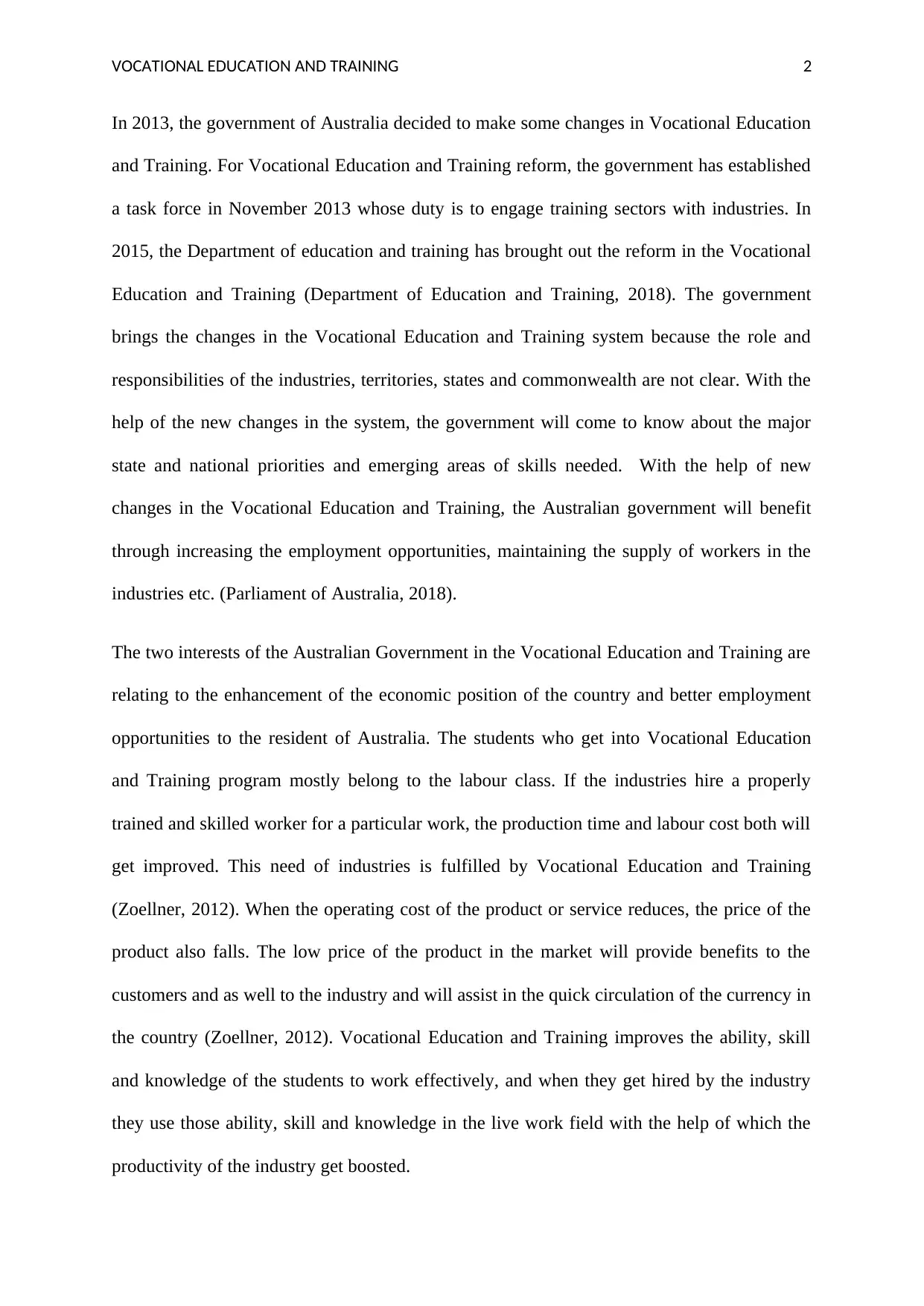
VOCATIONAL EDUCATION AND TRAINING 2
In 2013, the government of Australia decided to make some changes in Vocational Education
and Training. For Vocational Education and Training reform, the government has established
a task force in November 2013 whose duty is to engage training sectors with industries. In
2015, the Department of education and training has brought out the reform in the Vocational
Education and Training (Department of Education and Training, 2018). The government
brings the changes in the Vocational Education and Training system because the role and
responsibilities of the industries, territories, states and commonwealth are not clear. With the
help of the new changes in the system, the government will come to know about the major
state and national priorities and emerging areas of skills needed. With the help of new
changes in the Vocational Education and Training, the Australian government will benefit
through increasing the employment opportunities, maintaining the supply of workers in the
industries etc. (Parliament of Australia, 2018).
The two interests of the Australian Government in the Vocational Education and Training are
relating to the enhancement of the economic position of the country and better employment
opportunities to the resident of Australia. The students who get into Vocational Education
and Training program mostly belong to the labour class. If the industries hire a properly
trained and skilled worker for a particular work, the production time and labour cost both will
get improved. This need of industries is fulfilled by Vocational Education and Training
(Zoellner, 2012). When the operating cost of the product or service reduces, the price of the
product also falls. The low price of the product in the market will provide benefits to the
customers and as well to the industry and will assist in the quick circulation of the currency in
the country (Zoellner, 2012). Vocational Education and Training improves the ability, skill
and knowledge of the students to work effectively, and when they get hired by the industry
they use those ability, skill and knowledge in the live work field with the help of which the
productivity of the industry get boosted.
In 2013, the government of Australia decided to make some changes in Vocational Education
and Training. For Vocational Education and Training reform, the government has established
a task force in November 2013 whose duty is to engage training sectors with industries. In
2015, the Department of education and training has brought out the reform in the Vocational
Education and Training (Department of Education and Training, 2018). The government
brings the changes in the Vocational Education and Training system because the role and
responsibilities of the industries, territories, states and commonwealth are not clear. With the
help of the new changes in the system, the government will come to know about the major
state and national priorities and emerging areas of skills needed. With the help of new
changes in the Vocational Education and Training, the Australian government will benefit
through increasing the employment opportunities, maintaining the supply of workers in the
industries etc. (Parliament of Australia, 2018).
The two interests of the Australian Government in the Vocational Education and Training are
relating to the enhancement of the economic position of the country and better employment
opportunities to the resident of Australia. The students who get into Vocational Education
and Training program mostly belong to the labour class. If the industries hire a properly
trained and skilled worker for a particular work, the production time and labour cost both will
get improved. This need of industries is fulfilled by Vocational Education and Training
(Zoellner, 2012). When the operating cost of the product or service reduces, the price of the
product also falls. The low price of the product in the market will provide benefits to the
customers and as well to the industry and will assist in the quick circulation of the currency in
the country (Zoellner, 2012). Vocational Education and Training improves the ability, skill
and knowledge of the students to work effectively, and when they get hired by the industry
they use those ability, skill and knowledge in the live work field with the help of which the
productivity of the industry get boosted.
⊘ This is a preview!⊘
Do you want full access?
Subscribe today to unlock all pages.

Trusted by 1+ million students worldwide
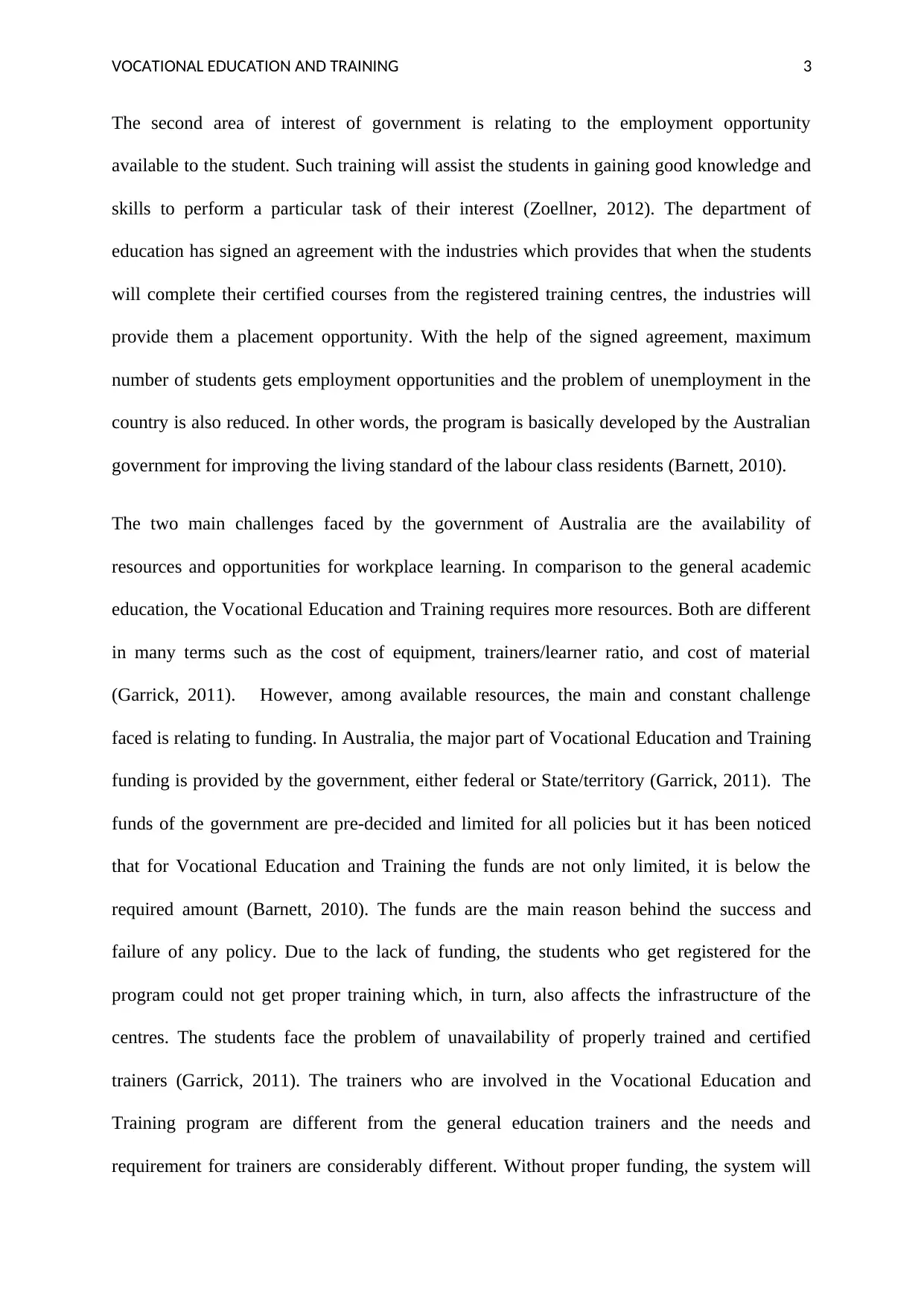
VOCATIONAL EDUCATION AND TRAINING 3
The second area of interest of government is relating to the employment opportunity
available to the student. Such training will assist the students in gaining good knowledge and
skills to perform a particular task of their interest (Zoellner, 2012). The department of
education has signed an agreement with the industries which provides that when the students
will complete their certified courses from the registered training centres, the industries will
provide them a placement opportunity. With the help of the signed agreement, maximum
number of students gets employment opportunities and the problem of unemployment in the
country is also reduced. In other words, the program is basically developed by the Australian
government for improving the living standard of the labour class residents (Barnett, 2010).
The two main challenges faced by the government of Australia are the availability of
resources and opportunities for workplace learning. In comparison to the general academic
education, the Vocational Education and Training requires more resources. Both are different
in many terms such as the cost of equipment, trainers/learner ratio, and cost of material
(Garrick, 2011). However, among available resources, the main and constant challenge
faced is relating to funding. In Australia, the major part of Vocational Education and Training
funding is provided by the government, either federal or State/territory (Garrick, 2011). The
funds of the government are pre-decided and limited for all policies but it has been noticed
that for Vocational Education and Training the funds are not only limited, it is below the
required amount (Barnett, 2010). The funds are the main reason behind the success and
failure of any policy. Due to the lack of funding, the students who get registered for the
program could not get proper training which, in turn, also affects the infrastructure of the
centres. The students face the problem of unavailability of properly trained and certified
trainers (Garrick, 2011). The trainers who are involved in the Vocational Education and
Training program are different from the general education trainers and the needs and
requirement for trainers are considerably different. Without proper funding, the system will
The second area of interest of government is relating to the employment opportunity
available to the student. Such training will assist the students in gaining good knowledge and
skills to perform a particular task of their interest (Zoellner, 2012). The department of
education has signed an agreement with the industries which provides that when the students
will complete their certified courses from the registered training centres, the industries will
provide them a placement opportunity. With the help of the signed agreement, maximum
number of students gets employment opportunities and the problem of unemployment in the
country is also reduced. In other words, the program is basically developed by the Australian
government for improving the living standard of the labour class residents (Barnett, 2010).
The two main challenges faced by the government of Australia are the availability of
resources and opportunities for workplace learning. In comparison to the general academic
education, the Vocational Education and Training requires more resources. Both are different
in many terms such as the cost of equipment, trainers/learner ratio, and cost of material
(Garrick, 2011). However, among available resources, the main and constant challenge
faced is relating to funding. In Australia, the major part of Vocational Education and Training
funding is provided by the government, either federal or State/territory (Garrick, 2011). The
funds of the government are pre-decided and limited for all policies but it has been noticed
that for Vocational Education and Training the funds are not only limited, it is below the
required amount (Barnett, 2010). The funds are the main reason behind the success and
failure of any policy. Due to the lack of funding, the students who get registered for the
program could not get proper training which, in turn, also affects the infrastructure of the
centres. The students face the problem of unavailability of properly trained and certified
trainers (Garrick, 2011). The trainers who are involved in the Vocational Education and
Training program are different from the general education trainers and the needs and
requirement for trainers are considerably different. Without proper funding, the system will
Paraphrase This Document
Need a fresh take? Get an instant paraphrase of this document with our AI Paraphraser
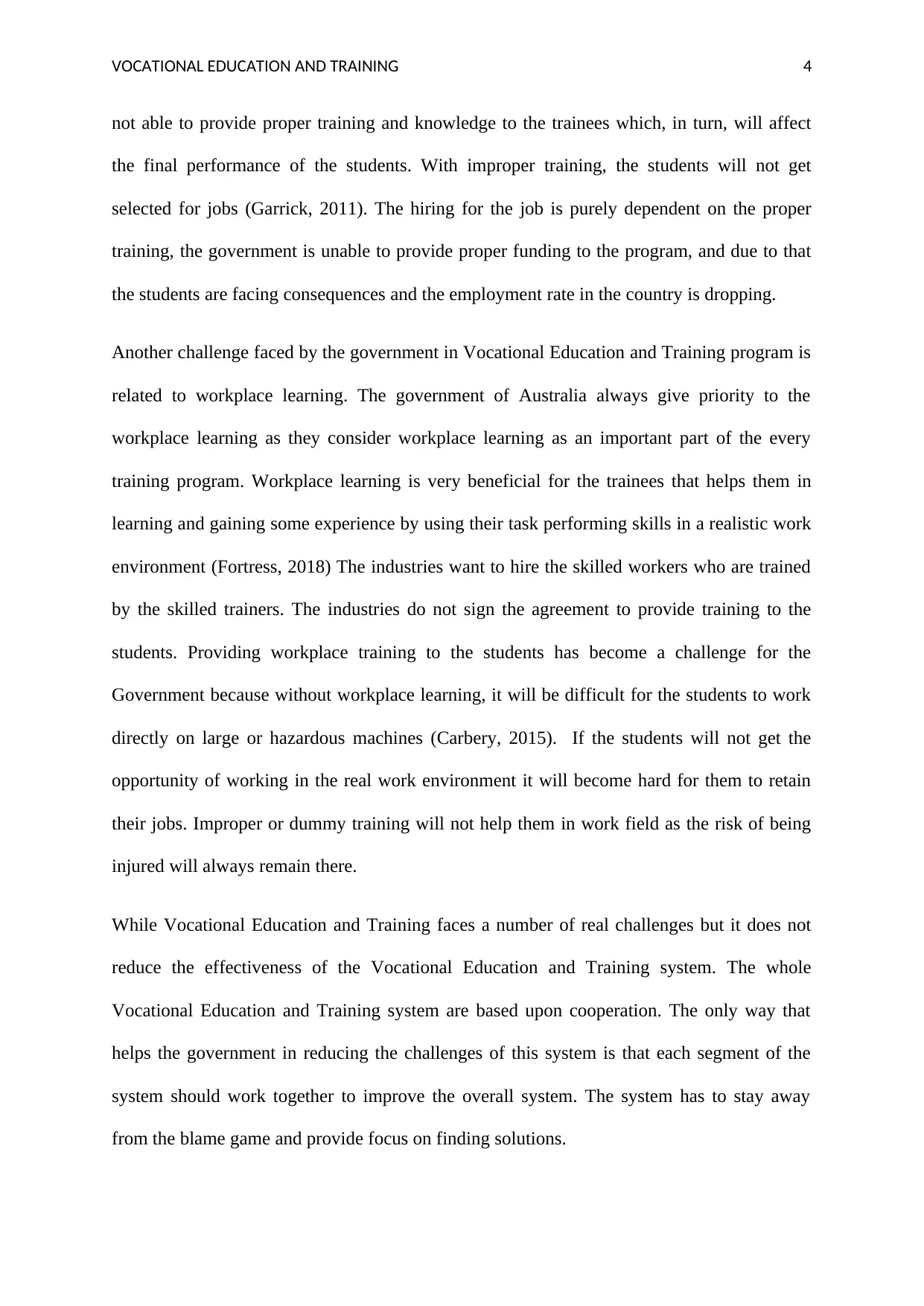
VOCATIONAL EDUCATION AND TRAINING 4
not able to provide proper training and knowledge to the trainees which, in turn, will affect
the final performance of the students. With improper training, the students will not get
selected for jobs (Garrick, 2011). The hiring for the job is purely dependent on the proper
training, the government is unable to provide proper funding to the program, and due to that
the students are facing consequences and the employment rate in the country is dropping.
Another challenge faced by the government in Vocational Education and Training program is
related to workplace learning. The government of Australia always give priority to the
workplace learning as they consider workplace learning as an important part of the every
training program. Workplace learning is very beneficial for the trainees that helps them in
learning and gaining some experience by using their task performing skills in a realistic work
environment (Fortress, 2018) The industries want to hire the skilled workers who are trained
by the skilled trainers. The industries do not sign the agreement to provide training to the
students. Providing workplace training to the students has become a challenge for the
Government because without workplace learning, it will be difficult for the students to work
directly on large or hazardous machines (Carbery, 2015). If the students will not get the
opportunity of working in the real work environment it will become hard for them to retain
their jobs. Improper or dummy training will not help them in work field as the risk of being
injured will always remain there.
While Vocational Education and Training faces a number of real challenges but it does not
reduce the effectiveness of the Vocational Education and Training system. The whole
Vocational Education and Training system are based upon cooperation. The only way that
helps the government in reducing the challenges of this system is that each segment of the
system should work together to improve the overall system. The system has to stay away
from the blame game and provide focus on finding solutions.
not able to provide proper training and knowledge to the trainees which, in turn, will affect
the final performance of the students. With improper training, the students will not get
selected for jobs (Garrick, 2011). The hiring for the job is purely dependent on the proper
training, the government is unable to provide proper funding to the program, and due to that
the students are facing consequences and the employment rate in the country is dropping.
Another challenge faced by the government in Vocational Education and Training program is
related to workplace learning. The government of Australia always give priority to the
workplace learning as they consider workplace learning as an important part of the every
training program. Workplace learning is very beneficial for the trainees that helps them in
learning and gaining some experience by using their task performing skills in a realistic work
environment (Fortress, 2018) The industries want to hire the skilled workers who are trained
by the skilled trainers. The industries do not sign the agreement to provide training to the
students. Providing workplace training to the students has become a challenge for the
Government because without workplace learning, it will be difficult for the students to work
directly on large or hazardous machines (Carbery, 2015). If the students will not get the
opportunity of working in the real work environment it will become hard for them to retain
their jobs. Improper or dummy training will not help them in work field as the risk of being
injured will always remain there.
While Vocational Education and Training faces a number of real challenges but it does not
reduce the effectiveness of the Vocational Education and Training system. The whole
Vocational Education and Training system are based upon cooperation. The only way that
helps the government in reducing the challenges of this system is that each segment of the
system should work together to improve the overall system. The system has to stay away
from the blame game and provide focus on finding solutions.
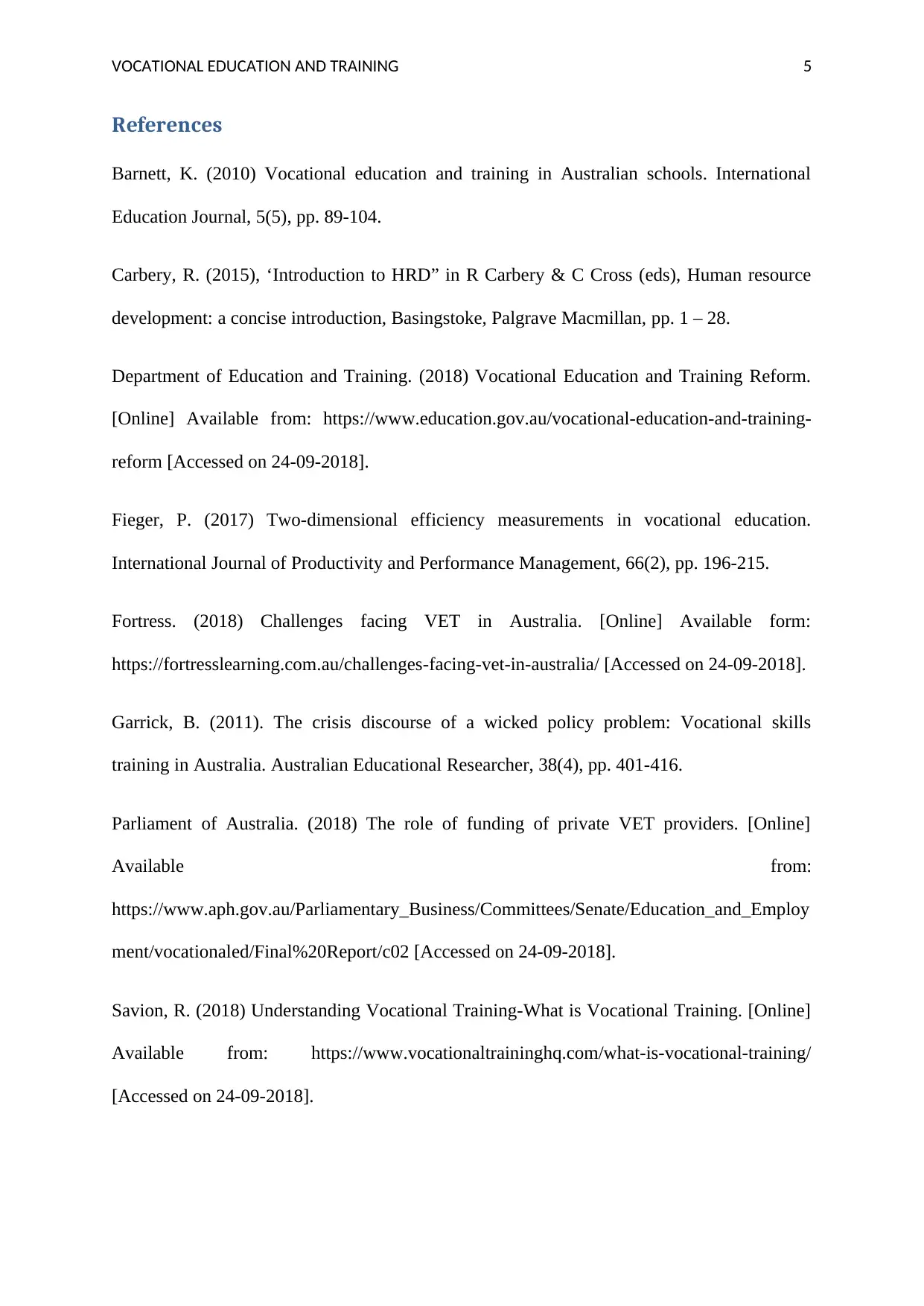
VOCATIONAL EDUCATION AND TRAINING 5
References
Barnett, K. (2010) Vocational education and training in Australian schools. International
Education Journal, 5(5), pp. 89-104.
Carbery, R. (2015), ‘Introduction to HRD” in R Carbery & C Cross (eds), Human resource
development: a concise introduction, Basingstoke, Palgrave Macmillan, pp. 1 – 28.
Department of Education and Training. (2018) Vocational Education and Training Reform.
[Online] Available from: https://www.education.gov.au/vocational-education-and-training-
reform [Accessed on 24-09-2018].
Fieger, P. (2017) Two-dimensional efficiency measurements in vocational education.
International Journal of Productivity and Performance Management, 66(2), pp. 196-215.
Fortress. (2018) Challenges facing VET in Australia. [Online] Available form:
https://fortresslearning.com.au/challenges-facing-vet-in-australia/ [Accessed on 24-09-2018].
Garrick, B. (2011). The crisis discourse of a wicked policy problem: Vocational skills
training in Australia. Australian Educational Researcher, 38(4), pp. 401-416.
Parliament of Australia. (2018) The role of funding of private VET providers. [Online]
Available from:
https://www.aph.gov.au/Parliamentary_Business/Committees/Senate/Education_and_Employ
ment/vocationaled/Final%20Report/c02 [Accessed on 24-09-2018].
Savion, R. (2018) Understanding Vocational Training-What is Vocational Training. [Online]
Available from: https://www.vocationaltraininghq.com/what-is-vocational-training/
[Accessed on 24-09-2018].
References
Barnett, K. (2010) Vocational education and training in Australian schools. International
Education Journal, 5(5), pp. 89-104.
Carbery, R. (2015), ‘Introduction to HRD” in R Carbery & C Cross (eds), Human resource
development: a concise introduction, Basingstoke, Palgrave Macmillan, pp. 1 – 28.
Department of Education and Training. (2018) Vocational Education and Training Reform.
[Online] Available from: https://www.education.gov.au/vocational-education-and-training-
reform [Accessed on 24-09-2018].
Fieger, P. (2017) Two-dimensional efficiency measurements in vocational education.
International Journal of Productivity and Performance Management, 66(2), pp. 196-215.
Fortress. (2018) Challenges facing VET in Australia. [Online] Available form:
https://fortresslearning.com.au/challenges-facing-vet-in-australia/ [Accessed on 24-09-2018].
Garrick, B. (2011). The crisis discourse of a wicked policy problem: Vocational skills
training in Australia. Australian Educational Researcher, 38(4), pp. 401-416.
Parliament of Australia. (2018) The role of funding of private VET providers. [Online]
Available from:
https://www.aph.gov.au/Parliamentary_Business/Committees/Senate/Education_and_Employ
ment/vocationaled/Final%20Report/c02 [Accessed on 24-09-2018].
Savion, R. (2018) Understanding Vocational Training-What is Vocational Training. [Online]
Available from: https://www.vocationaltraininghq.com/what-is-vocational-training/
[Accessed on 24-09-2018].
⊘ This is a preview!⊘
Do you want full access?
Subscribe today to unlock all pages.

Trusted by 1+ million students worldwide
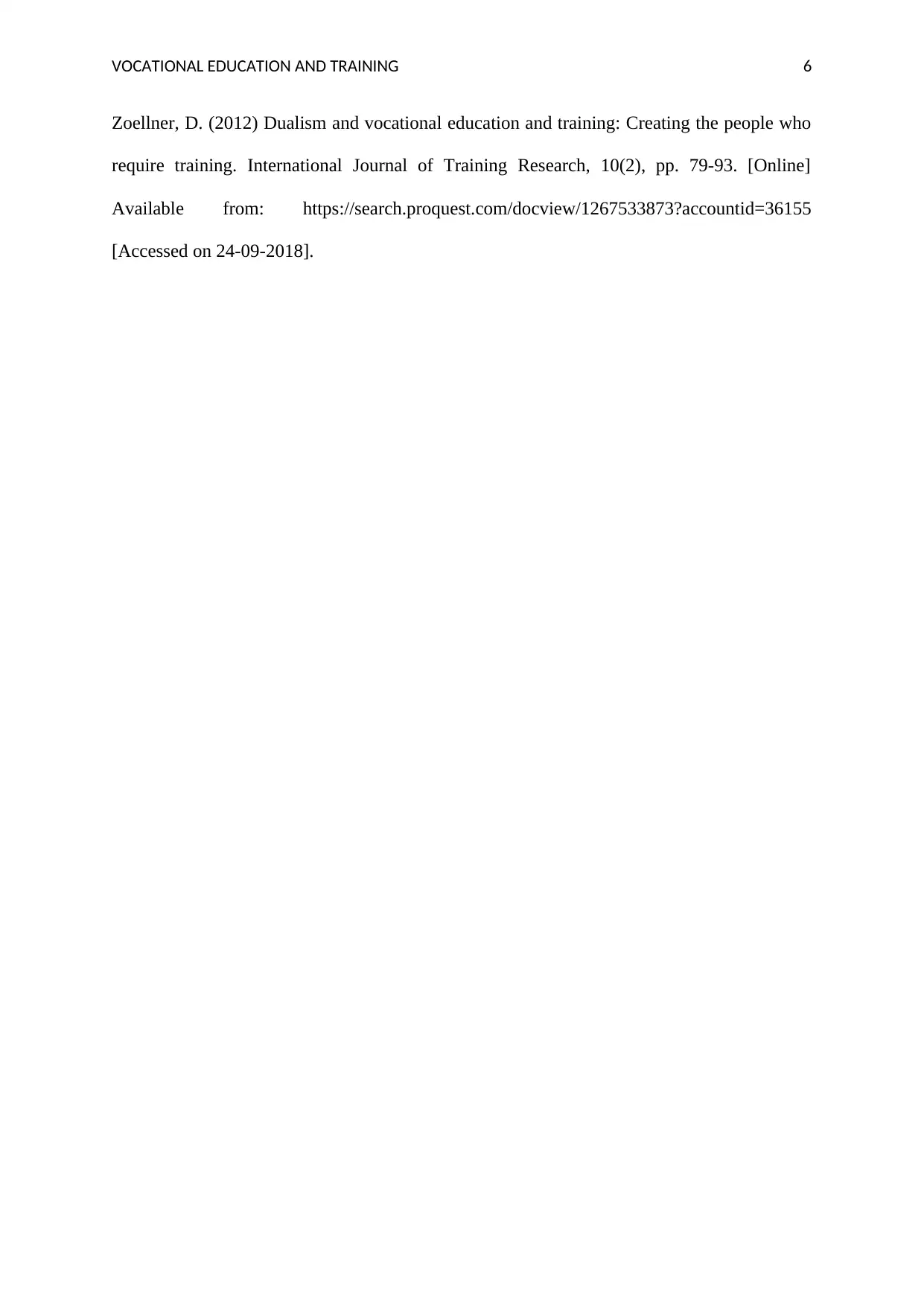
VOCATIONAL EDUCATION AND TRAINING 6
Zoellner, D. (2012) Dualism and vocational education and training: Creating the people who
require training. International Journal of Training Research, 10(2), pp. 79-93. [Online]
Available from: https://search.proquest.com/docview/1267533873?accountid=36155
[Accessed on 24-09-2018].
Zoellner, D. (2012) Dualism and vocational education and training: Creating the people who
require training. International Journal of Training Research, 10(2), pp. 79-93. [Online]
Available from: https://search.proquest.com/docview/1267533873?accountid=36155
[Accessed on 24-09-2018].
1 out of 7
Related Documents
Your All-in-One AI-Powered Toolkit for Academic Success.
+13062052269
info@desklib.com
Available 24*7 on WhatsApp / Email
![[object Object]](/_next/static/media/star-bottom.7253800d.svg)
Unlock your academic potential
Copyright © 2020–2025 A2Z Services. All Rights Reserved. Developed and managed by ZUCOL.





